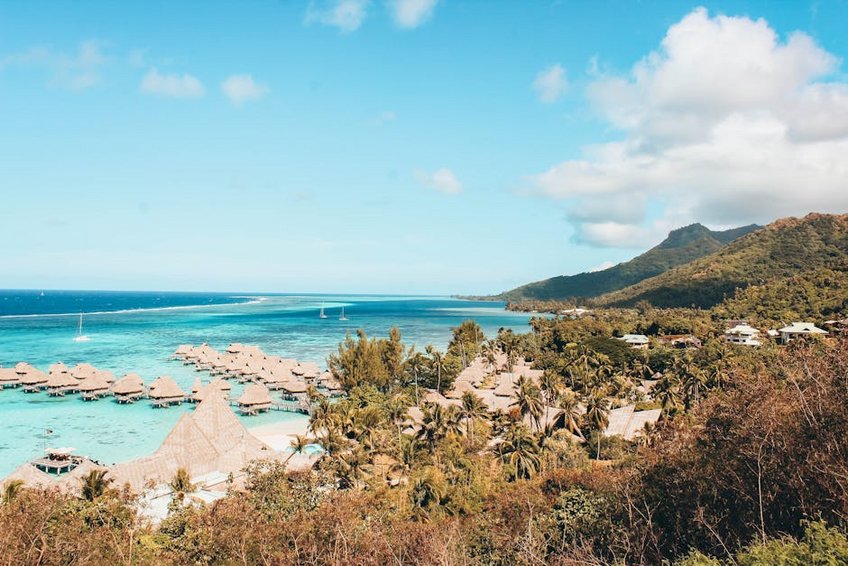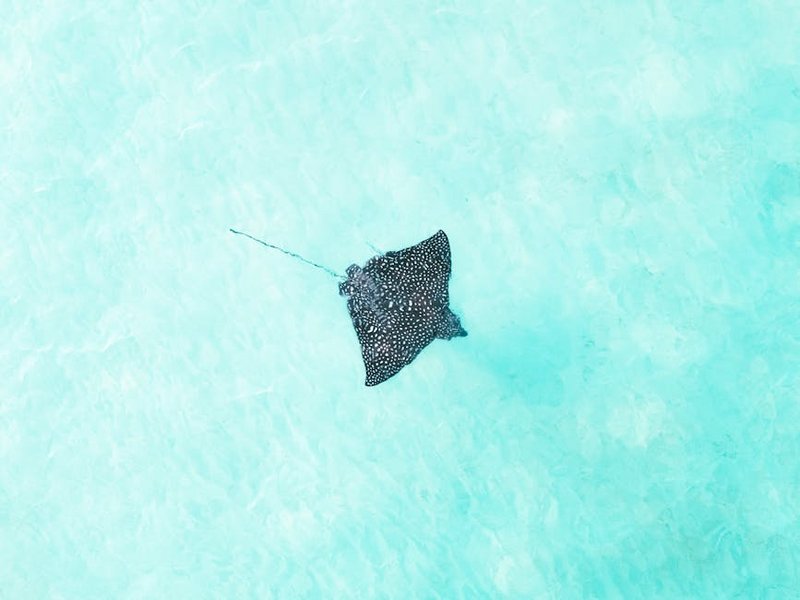French Polynesia Moorea Stingray Encounter: Swimming with Gentle Giants
Swimming alongside stingrays in Moorea’s turquoise lagoons offers an unforgettable wildlife interaction just a short boat ride from Tahiti. Your French Polynesia Moorea stingray encounter brings you face-to-face with Southern Stingrays and Blacktip Reef Sharks in shallow, crystalline waters. This guide covers planning essentials, seasonal timing, and local operator insights for your aquatic adventure.
Essential Moorea Information
Moorea lies 17 kilometers northwest of Tahiti within French Polynesia’s Society Islands archipelago. The island spans 134 square kilometers with a population around 16,000 residents. Volcanic peaks create dramatic backdrops for its famous lagoons and coral reefs.
French remains the official language while Tahitian and English see common usage in tourist areas. The tropical climate maintains 80-86°F (27-30°C) year-round with higher humidity November through April. You’ll need valid passport documentation for stays under 90 days as a US or EU citizen.
Moorea’s Marine Environment
These stingray encounters occur primarily at three shallow sandbars in Opunohu and Cook’s Bays.
- Southern Stingrays measure 4-5 feet across with smooth skin and whip-like tails lacking stingers in this location.
- Blacktip Reef Sharks typically 3-4 feet long often accompany rays during feeding sessions.
- Coral gardens surrounding the sites host parrotfish, angelfish, and occasional sea turtles.
- Budget tours at $60-75 include basic stingray/snorkeling with shared transfers from Vaiare Ferry.
- Mid-range $80-100 packages add shark feeding, hotel pickup, and photo services.
- Premium $110-120 options feature private guides, gourmet lunch, and extended time.
- Tahiti Tourisme Official Site
- Lonely Planet Moorea Guide
Historical and Cultural Context
Polynesians first settled Moorea approximately 1,000 years before European explorers arrived. The stingray feeding tradition began in the 1990s when local guides started attracting rays with fish scraps. Today’s encounters follow strict ecological guidelines to protect marine life behavior.
Traditional Polynesian culture emphasizes reverence for marine creatures as spiritual ancestors. Modern conservation efforts balance tourism revenue with lagoon preservation. Your visit supports local families directly through guide fees and conservation donations.
Experience Levels and Accessibility
First-time snorkelers comfortably participate with basic swimming ability and provided equipment. Guides assist non-swimmers using flotation devices during the shallow water interactions. Children aged five and above typically enjoy the experience with parental supervision.
Boat transfers require stepping down a ladder into waist-deep water. Operators accommodate mobility limitations with advance notification. Morning tours experience calmer conditions than afternoon departures.

Alt: “moorea-stingray-encounter-lagoon-clear-waters”
French Polynesia Moorea Stingray Encounter – Planning Your Trip
Booking your French Polynesia Moorea stingray encounter requires selecting reputable operators months ahead during peak seasons. The experience combines well with shark feeding and coral garden snorkeling in half-day excursions. You’ll want waterproof cameras and reef-safe sunscreen for optimal enjoyment.
Tour prices range $60-120 per person depending on inclusion of hotel transfers and additional activities. Most operators provide mask, snorkel, fins, and sometimes underwater cameras for rent. Confirm whether lunch or snacks feature in your chosen package details.
Plan additional days for exploring Moorea’s interior jungles and pineapple plantations. The stingray encounter typically occupies 3-4 hours including boat transportation time. Combine with a circle island tour for comprehensive Moorea immersion.
Best Time to Visit Moorea for Stingray Encounters
May through October delivers ideal conditions with minimal rainfall and water visibility exceeding 100 feet. Temperatures hover between 75-82°F (24-28°C) with low humidity and consistent trade winds. This dry season sees higher tourist numbers requiring earlier reservations.
November through April brings warmer 80-86°F (27-30°C) temperatures with possible afternoon showers. Fewer visitors mean more intimate experiences though occasional storms may cancel tours. Shoulder months April and November balance decent weather with moderate crowds.
Budget Planning and Costs
Tour pricing varies by inclusions and group size.
Essential Preparation Checklist
Pack quick-dry clothing, swimwear, and waterproof bags for the boat journey. Bring certified reef-safe sunscreen to protect fragile coral ecosystems. Water shoes prove useful for walking on coral debris near the sandbars.
Secure travel insurance covering adventure activities and weather cancellations. Book accommodations three months early for June-August visits. Check passport validity extends six months beyond your departure date.
Top Attractions and Activities
Moorea’s compact size enables experiencing diverse landscapes within short driving distances. The 37-mile coastal road circles the entire island in under two hours. Inland adventures reveal waterfalls, archaeological sites, and panoramic viewpoints.
Belvedere Lookout delivers spectacular views over Cook’s and Opunohu Bays simultaneously. Magic Mountain provides 360-degree island perspectives after a moderate hike. Tropical gardens like Tiki Village showcase traditional Polynesian culture.
Must-See Highlights
Cook’s Bay and Opunohu Bay feature stunning aquamarine waters against jagged mountain backdrops. These sheltered bays offer paddleboarding, kayaking, and sailing excursions beyond stingray encounters. Several beachfront restaurants serve fresh seafood with magnificent sunset views.
Rotui Juice Factory tours demonstrate local pineapple and fruit wine production. The agricultural school nearby sells tropical fruit baskets and homemade jams. These stops complement ocean activities with cultural insights.
Hidden Gems and Local Favorites
Paopao Valley’s agricultural cooperatives welcome visitors for fruit tasting and farm tours. Local guides share knowledge about vanilla cultivation and noni fruit uses. These experiences support community-based tourism initiatives.
Temae Beach public access area features Moorea’s longest white-sand beach without resort crowds. The snorkeling right offshore reveals healthy coral formations and diverse fish species. Pack a picnic and spend a full day enjoying this local favorite spot.
Additional Marine Adventures
Dolphin watching tours depart early mornings when marine mammals feed near the reef passes. Whale watching operates July through November during humpback migration seasons. Glass-bottom boat tours appeal to non-swimmers wanting lagoon visibility.
Scuba diving sites include the wreck of the cargo ship Nordby and mythical Lemon Shark Valley. PADI certification courses available at multiple dive centers around the island. Night dives reveal octopus, lobsters, and bioluminescent organisms.
Practical Travel Information
Moorea receives visitors via 30-minute ferry from Papeete or 10-minute flight from Faa’a International Airport. Rental cars, scooters, and bicycles provide independent exploration options. The island’s limited public transportation makes pre-booking transfers advisable.
Accommodation ranges from luxury overwater bungalows to family-run guesthouses. Most properties cluster around the two main bays for easy water access. Booking directly with hotels often secures better rates than third-party sites.
| Accommodation Type | Features and Locations | Price Range (USD) |
|---|---|---|
| Luxury Resorts | Overwater bungalows, infinity pools, spas, multiple restaurants | $400-800/night |
| Mid-Range Hotels | Beachfront rooms, breakfast included, snorkeling gear | $150-350/night |
| Vacation Rentals | Full kitchens, private gardens, local neighborhoods | $80-200/night |
| Guesthouses | Host families, homemade meals, cultural exchange | $50-120/night |


